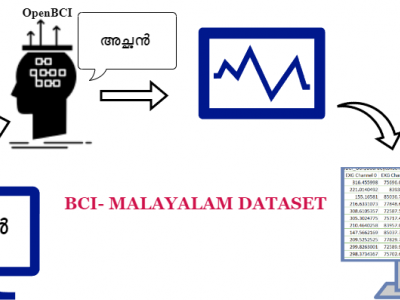.txt
This paper introduces a dataset capturing brain signals generated by the recognition of 100 Malayalam words, accompanied by their English translations. The dataset encompasses recordings acquired from both vocal and sub-vocal modalities for the Malayalam vocabulary. For the English equivalents, solely vocal signals were collected. This dataset is created to help Malayalam speaking patients with neuro-degenerative diseases.
- Categories:
 537 Views
537 ViewsIn today’s context, it is essential to develop technologies to help older patients with neurocognitive disorders communicate better with their caregivers. Research in Brain Computer Interface, especially in thought-to-text translation has been carried out in several languages like Chinese, Japanese and others. However, research of this nature has been hindered in India due to scarcity of datasets in vernacular languages, including Malayalam. Malayalam is a South Indian language, spoken primarily in the state of Kerala by bout 34 million people.
- Categories:
 617 Views
617 Views
The Deepfake face detection task involves a facial image of unknown authenticity for testing. While most deepfake detection methods take only the image as input, our literature demonstrates that conditioning the deepfake detector on identity—i.e., knowing whose deepfake face the picture might be—can enhance detection performance. Existing deepfake detection datasets, such as FaceForensics++ and DFDC, do not include identity information for authentic and deepfake faces.
- Categories:
 721 Views
721 ViewsAn understanding of local walking context plays an important role in the analysis of gait in humans and in the high level control systems of robotic prostheses. Laboratory analysis on its own can constrain the ability of researchers to properly assess clinical gait in patients and robotic prostheses to function well in many contexts, therefore study in diverse walking environments is warranted. A ground-truth understanding of the walking terrain is traditionally identified from simple visual data.
- Categories:
 178 Views
178 Views
The dataset contained walking data of 41 volunteers, including 20 women and 21 men. Each volunteer walked on asphalt and SLATE roads for six times, each time for less than one minute. In addition, the dataset also included gait data on stairs and stairs. The data acquisition frequency is 100HZ, and a total of four sensors are used to collect data. The sensor numbered 001 is located on the left knee, the sensor numbered 001 is located on the right wrist, the sensor numbered 003 is located on the left ankle, and the sensor 004 is located on the back of the waist.
- Categories:
 254 Views
254 ViewsIn the realm of real-time communications, WebRTC-based multimedia applications are increasingly prevalent as these can be smoothly integrated within Web browsing sessions. The browsing experience is then significantly improved concerning scenarios where browser add-ons and/or plug-ins are used; still, the end user's Quality of Experience (QoE) in WebRTC sessions may be affected by network impairments, such as delays and losses.
- Categories:
 247 Views
247 ViewsLoceva - an evaluation tool for 802.11-based positioning systems.
Loceva is an evaluation tool for 802.11-based positioning systems. Loceva uses trace files generated by Loctrace to evaluate different kinds of positioning algorithms. A large number of state-of-the-art positioning algorithms are supported by Loceva. Loceva contains a lot of filters and generators to set up different scenarios and enable emulation.
Lastmodified :
2007-12-05
Dataname :
tools/analyze/location/loceva
File :
- Categories:
 60 Views
60 ViewsTo investigate whether a large-scale Bluetooth worm outbreak is viable in practice, we conducted controlled experiments and we gathered traces of Bluetooth activity in different urban environments to determine the feasibility of a worm infection
date/time of measurement start: 2005-11-16
date/time of measurement end: 2005-11-26
- Categories:
 152 Views
152 Views





